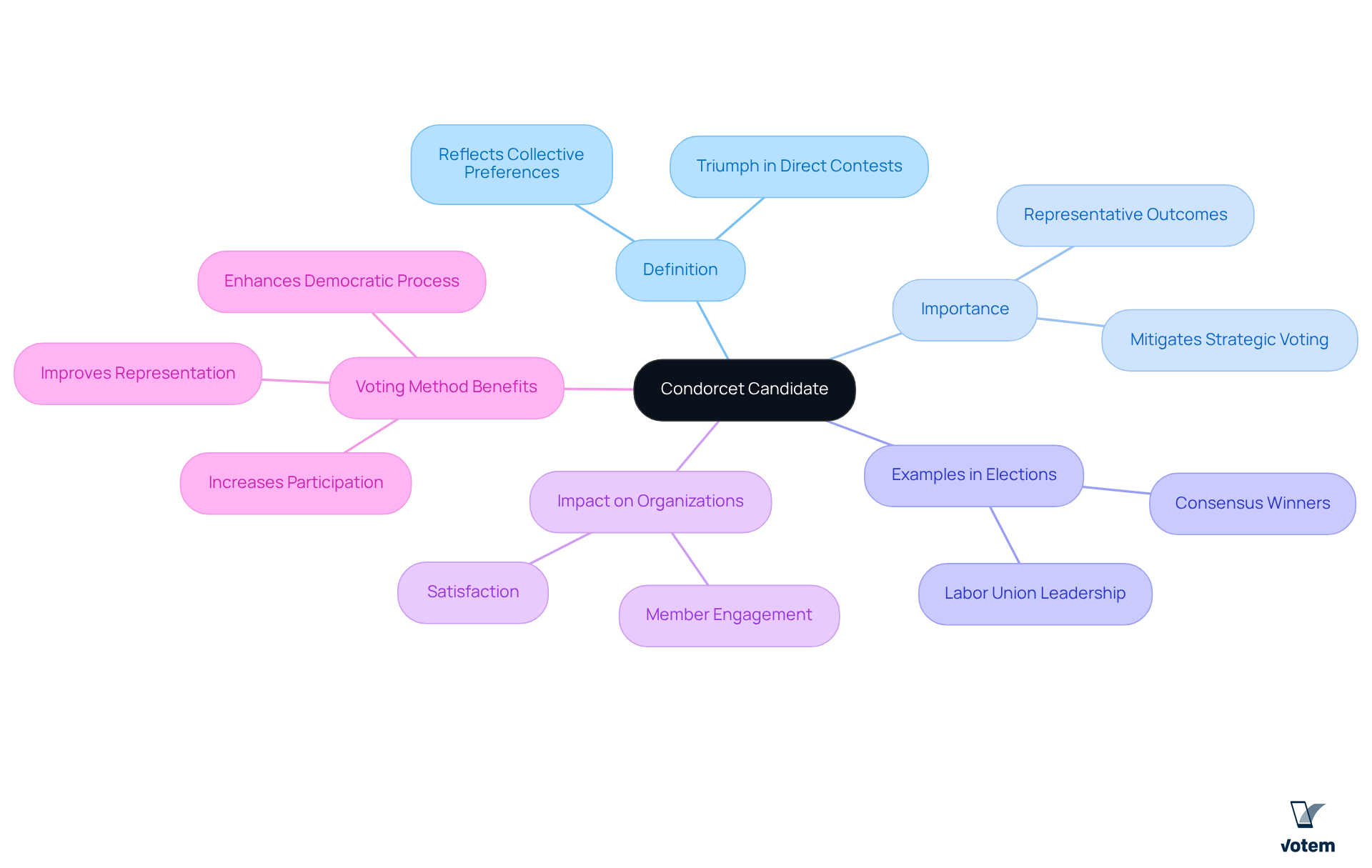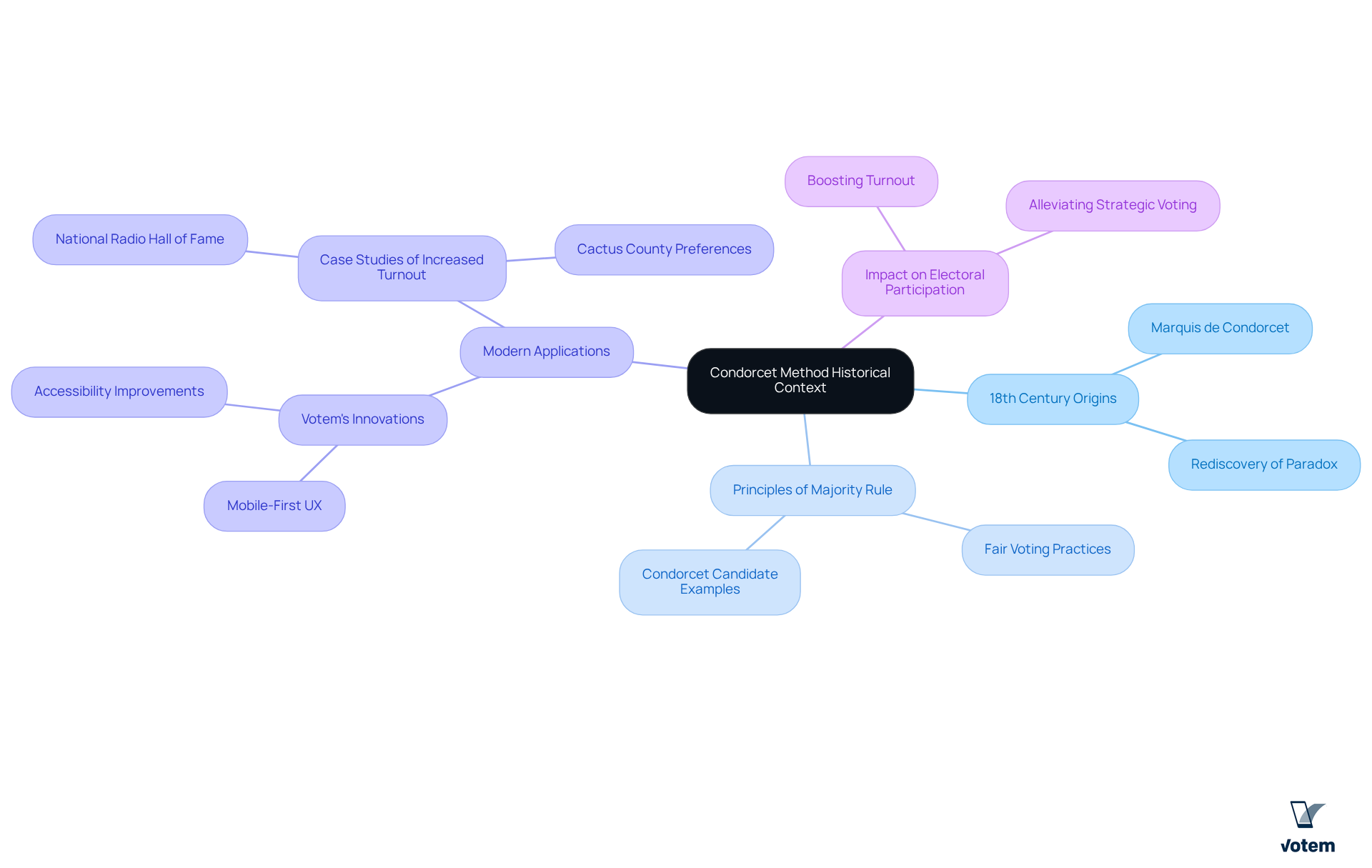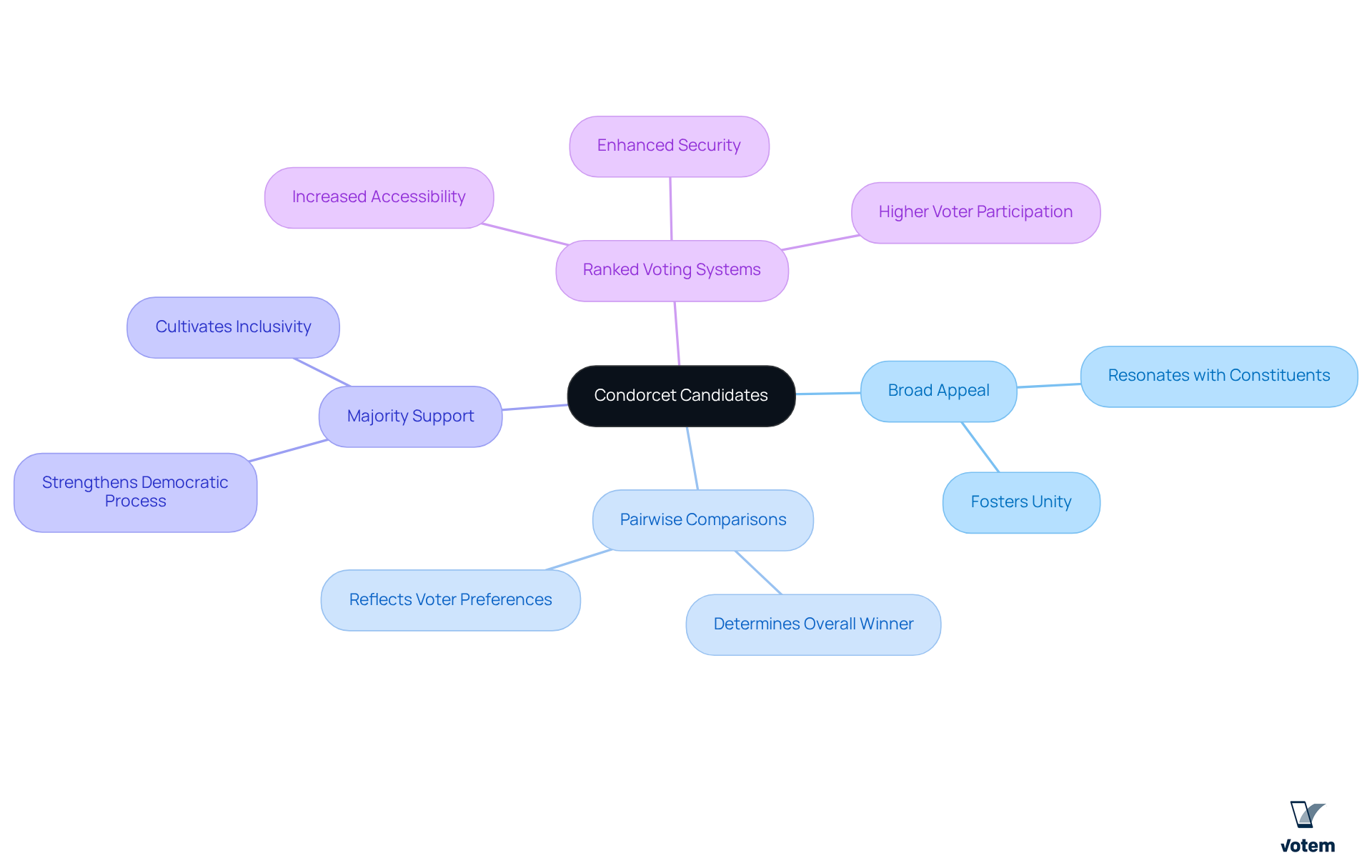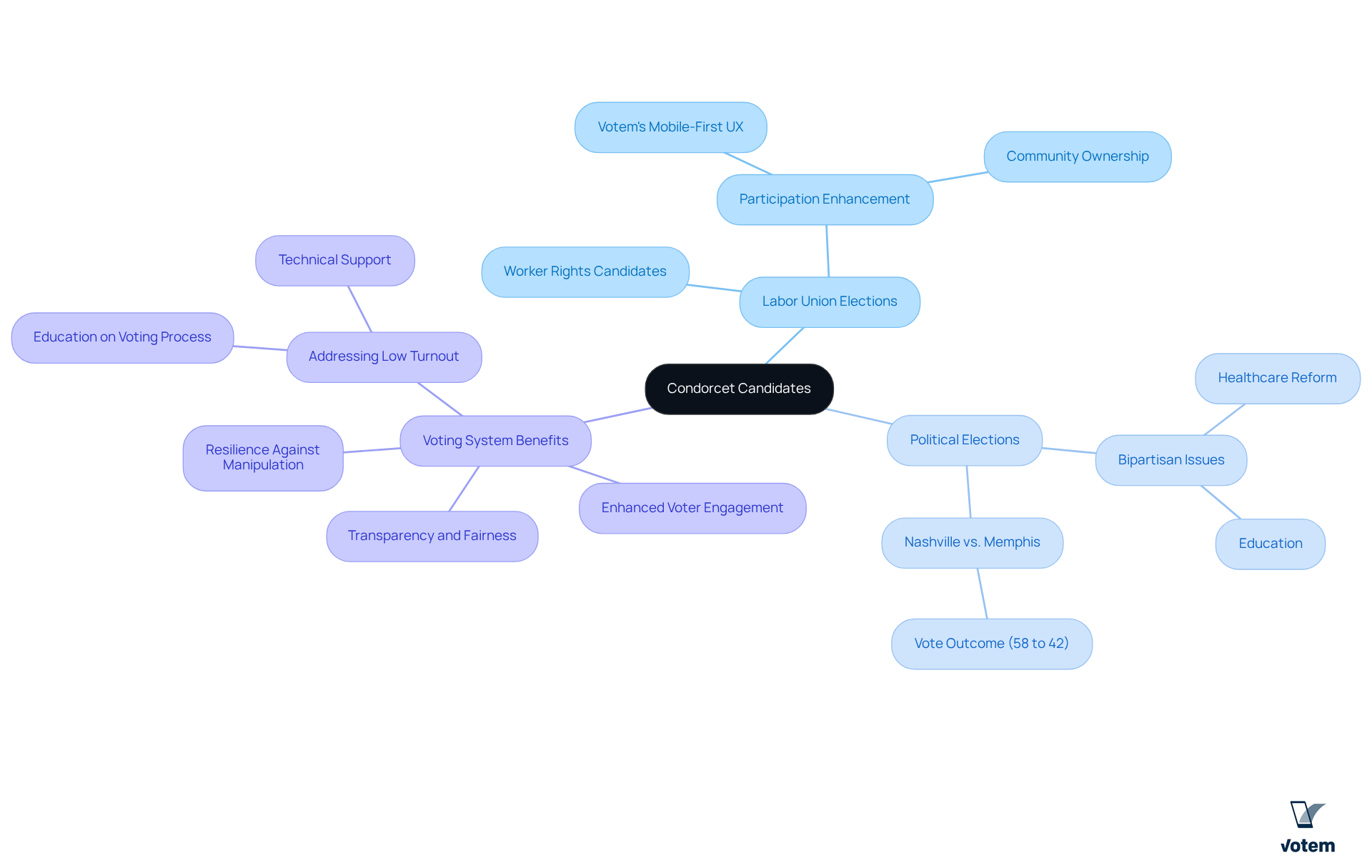Overview
A Condorcet candidate is defined as an individual in an election who would triumph over all other candidates in direct pairwise contests, thereby reflecting the preferences of the majority. This concept significantly enhances democratic processes by promoting fairer representation and mitigating strategic voting.
Furthermore, its successful application in various electoral scenarios, including labor unions and political elections, underscores its effectiveness. By embracing the idea of a Condorcet candidate, union leadership can foster a more equitable electoral environment, ultimately leading to stronger representation and increased member engagement.
Introduction
Understanding the dynamics of electoral systems is crucial in a world where the integrity of democratic processes is constantly under scrutiny. The emergence of the Condorcet candidate stands as a pivotal element in promoting fair representation, identifying individuals who would triumph in head-to-head matchups against all competitors. This article delves into the significance of Condorcet candidates, exploring their defining characteristics, historical context, and real-world examples that underscore their impact on electoral outcomes.
Furthermore, what challenges do these candidates face in ensuring that the collective preferences of the electorate are truly reflected?
Define Condorcet Candidate: Understanding the Concept
A preferred nominee, often referred to as a condorcet candidate example, is defined as an individual or choice in an election that would triumph in direct contests against all other participants. This concept is rooted in the desire to identify the condorcet candidate example that is most favored by the majority. The importance of a preferred choice is underscored by its capacity to authentically reflect the collective preferences of the electorate, leading to more representative and equitable electoral outcomes.
For instance, in various political elections, candidates recognized as consensus winners have demonstrated a stronger alignment with public preferences compared to those selected through traditional methods. This is particularly crucial for organizations such as labor unions, where the selection of leadership can significantly influence member engagement and satisfaction. Furthermore, expert opinions highlight that this voting method not only enhances the democratic process but also mitigates the risk of strategic voting, fostering a more inclusive electoral environment.
Statistics indicate that the implementation of this voting technique can substantially improve the representation of voter preferences, making it an essential element for any electoral system striving for fairness and transparency. In light of these insights, union leadership should consider adopting this approach to ensure that their electoral processes are both effective and reflective of their members’ true preferences.

Explore the Historical Context of the Condorcet Method
The voting system, which serves as a condorcet candidate example, emerged in the 18th century and is named after the French philosopher and mathematician Marquis de Condorcet, highlighting its significance in democratic theory. Condorcet emphasized the significance of majority rule and the necessity for fair voting practices, highlighting this with a condorcet candidate example, particularly in elections with multiple candidates. His principles established the foundation for a more just electoral system, promoting approaches that represent the genuine preferences of the electorate, such as the condorcet candidate example. As this approach evolved, it inspired various adaptations that have significantly shaped contemporary electoral systems, fostering discussions around fairness, representation, and the integrity of democratic processes.
Today, this method is acknowledged for its potential to boost electoral participation and alleviate issues such as strategic voting, establishing it as an essential element in the continuous development of electoral practices. Votem’s innovative online voting solutions exemplify this potential, having successfully managed over 13 million votes, thereby reinforcing the reliability of this approach in real-world elections. Specifically, Votem’s services improve accessibility for all participants, including military personnel and individuals with disabilities, as emphasized by numerous testimonials from satisfied clients.
The historical context of the paradox rediscovered in the late 18th century highlights the complexities inherent in majority rule and the significance of addressing these challenges in modern electoral systems. Votem’s transformative impact on turnout is further evidenced by its success in managing large-scale voting events, such as the National Radio Hall of Fame, where they handled 299,000 votes, significantly increasing participation compared to previous years. This underscores the importance of adopting such innovative solutions to enhance electoral engagement and integrity.

Identify Key Characteristics of Condorcet Candidates
An example of a condorcet candidate is one that is distinguished by its broad appeal and its ability to excel in pairwise comparisons against all competitors, effectively embodying the preferences of the majority. These candidates participate in elections that utilize ranked voting systems, allowing voters to express nuanced preferences. This methodology acknowledges those who resonate with the largest group of constituents and fosters unity, making it particularly crucial in labor union elections where collective decision-making is paramount. By guaranteeing that the chosen candidate has the support of the majority, this approach strengthens the democratic process, cultivating a sense of inclusivity and shared purpose among union members.
Votem’s cutting-edge online voting solutions significantly enhance both accessibility and security, as demonstrated by testimonials from satisfied clients. One client remarked, ‘Implementing Votem’s new, modern system which allowed greater access for all qualified participants from military members to individuals with disabilities was my greatest accomplishment in office.’ Furthermore, this voting method has the potential to dramatically increase voter participation, with estimates suggesting that engagement could triple on launch day due to its user-friendly platforms. As another testimonial underscores, ‘Votem successfully handled the receipt of 299,000 votes on behalf of the National Radio Hall of Fame, an increase over last year’s 126,000 votes received.

Examine Real-World Examples of Condorcet Candidates
Real-world instances of specific individuals illustrate their considerable influence across various electoral scenarios. In labor union elections, candidates who champion worker rights and advocate for collective bargaining frequently emerge as a Condorcet candidate example, resonating with the majority of union members. This alignment with member interests not only enhances participation but also fosters a sense of community ownership in the electoral process. Significantly, Votem’s pioneering online voting solutions have been crucial in improving accessibility, enabling increased involvement from all eligible individuals, including military personnel and those with disabilities. The method can potentially enhance participation by as much as three times on launch day due to Votem’s mobile-first UX, further underscoring the importance of involving union members in the voting process.
In political elections, individuals addressing bipartisan issues—such as healthcare reform and education—often serve as optimal choices, appealing to a varied electorate. For example, Nashville’s recent triumph over Memphis in a vote for the capital of Tennessee illustrates how a preferred choice can effectively represent the preferences of the electorate, winning by 58% to 42%.
These instances emphasize the significance of understanding electoral preferences and the potential for specific candidates to promote more representative and effective governance. The benefits of the voting system—including its resilience against strategic manipulation and its potential to enhance voter engagement—make it a compelling choice for unions seeking to uphold transparency and fairness in their electoral processes. However, addressing challenges such as low turnout and technical difficulties is vital for maintaining confidence in the electoral system. By educating union members about the voting process and fostering community involvement, the Condorcet candidate example can enhance the integrity of elections, ultimately strengthening democratic processes.

Conclusion
A Condorcet candidate represents a choice in an election that can triumph over all other candidates in direct comparisons, underscoring the critical role of majority preference in electoral processes. This concept not only highlights the necessity for fair representation but also bolsters the democratic integrity of elections. By pinpointing candidates who resonate with the majority, the Condorcet method guarantees that electoral outcomes mirror the true will of the people, thereby fostering a more inclusive and equitable political landscape.
Throughout this discussion, key arguments illuminate the historical significance of the Condorcet method, its potential to enhance voter participation, and the traits that characterize successful Condorcet candidates. Historical examples illustrate its evolution and relevance in contemporary voting systems, particularly within labor unions where collective decision-making is essential. Furthermore, real-world instances of Condorcet candidates demonstrate their ability to effectively unite diverse groups around shared interests, leading to more representative governance.
Ultimately, embracing the Condorcet method can revolutionize electoral practices by prioritizing voter preferences and enhancing engagement. Successful implementations, such as those by Votem, showcase how this approach can significantly boost participation and fortify the integrity of democratic processes. Encouraging organizations and electoral bodies to consider the Condorcet method not only promotes fairness but also reinforces the fundamental principles of democracy, ensuring that every voice is heard and valued.
Frequently Asked Questions
What is a condorcet candidate?
A condorcet candidate is an individual or choice in an election that would win in direct contests against all other participants, reflecting the majority’s preference.
Why is identifying a condorcet candidate important?
Identifying a condorcet candidate is important because it helps to authentically reflect the collective preferences of the electorate, leading to more representative and equitable electoral outcomes.
How do condorcet candidates compare to those selected through traditional methods?
Candidates recognized as consensus winners, or condorcet candidates, tend to demonstrate a stronger alignment with public preferences compared to those selected through traditional voting methods.
In what contexts is the concept of a condorcet candidate particularly crucial?
The concept is particularly crucial in contexts such as labor unions, where the selection of leadership can significantly influence member engagement and satisfaction.
What are the benefits of using the condorcet voting method?
The condorcet voting method enhances the democratic process, mitigates the risk of strategic voting, and fosters a more inclusive electoral environment.
How does implementing the condorcet voting technique affect voter representation?
Implementing the condorcet voting technique can substantially improve the representation of voter preferences, making it essential for electoral systems striving for fairness and transparency.
What should union leadership consider regarding the condorcet candidate approach?
Union leadership should consider adopting the condorcet candidate approach to ensure that their electoral processes are effective and reflective of their members’ true preferences.
List of Sources
- Define Condorcet Candidate: Understanding the Concept
- Condorcet Social Choice Functions | SIAM Journal on Applied Mathematics (https://epubs.siam.org/doi/abs/10.1137/0133030)
- Implementing the Condorcet Method for Union Elections | Online Voting with Votem® (https://votem.com/implementing-the-condorcet-method-for-union-elections)
- Condorcet Voting – Center for Effective Government (https://effectivegov.uchicago.edu/primers/condorcet-voting)
- Explore the Historical Context of the Condorcet Method
- Implementing the Condorcet Method for Union Elections | Online Voting with Votem® (https://votem.com/implementing-the-condorcet-method-for-union-elections)
- Condorcet paradox – Wikipedia (https://en.wikipedia.org/wiki/Condorcet_paradox)
- Exploring Condorcet Voting: A Practical Example (https://medium.com/@Gbgrow/exploring-condorcet-voting-a-practical-example-778152b8b11f)
- Condorcet Voting – Center for Effective Government (https://effectivegov.uchicago.edu/primers/condorcet-voting)
- Identify Key Characteristics of Condorcet Candidates
- Implementing the Condorcet Method for Union Elections | Online Voting with Votem® (https://votem.com/implementing-the-condorcet-method-for-union-elections)
- Condorcet Voting System – ElectionBuddy (https://electionbuddy.com/condorcet-voting-system)
- Examine Real-World Examples of Condorcet Candidates
- Implementing the Condorcet Method for Union Elections | Online Voting with Votem® (https://votem.com/implementing-the-condorcet-method-for-union-elections)

